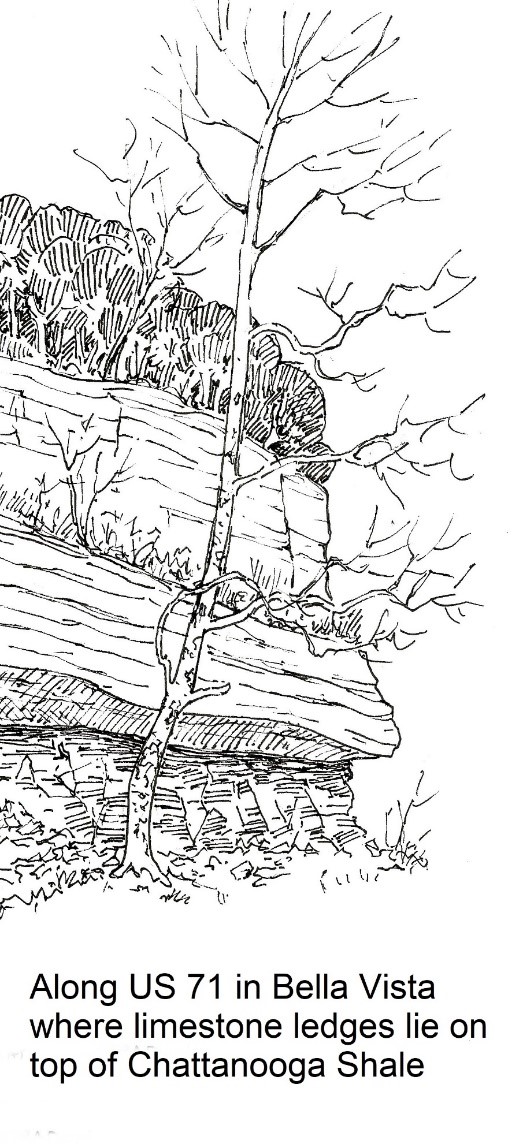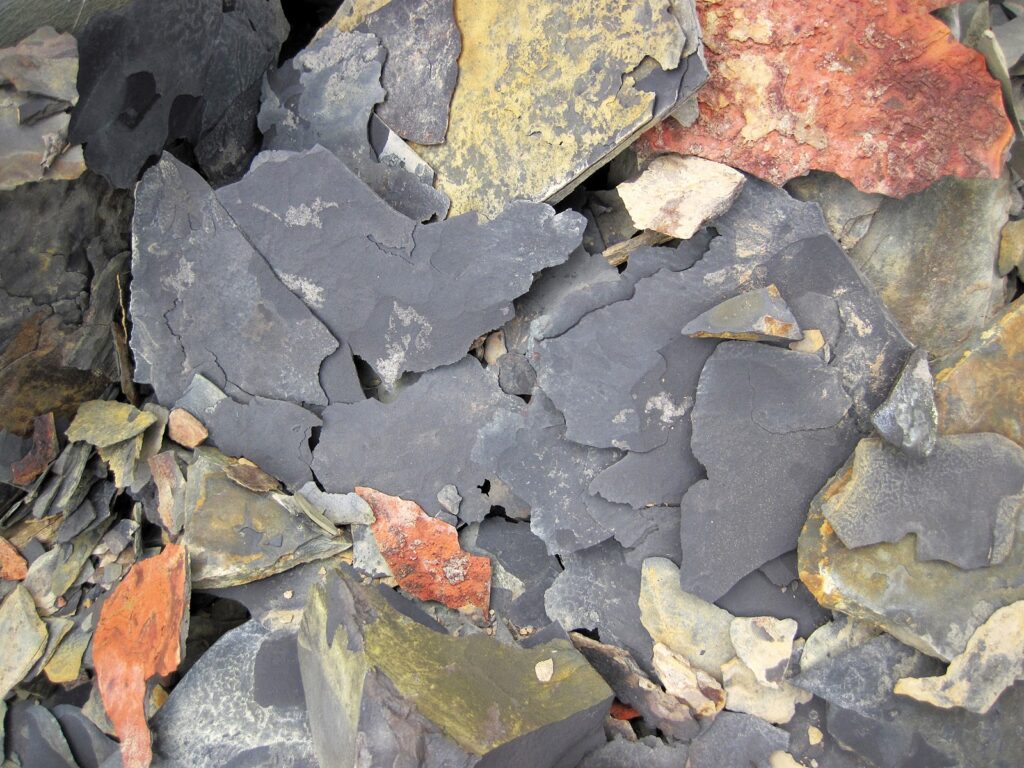By Fred Paillet, OS Education Chair
Mysteries have always been of great interest to readers, and we have a fascinating example of a mystery right here in our Ozark Mountains that relates to the rocks under our own feet – and even has a possible biblical implication. If you were stuck on US 71 in Bella Vista before the I-49 bypass was opened or have hiked past some of the rock shelters along the Back Forty trails you have seen the near vertical walls of layered limestone forming steep cliffs. Geologists call this the St Joe member of the Boone Limestone deposited about 300 million years ago. That was during what we hear of as the Coal Age when vast swamplands of primitive plants covered the lowlands east of the Ozark Plateau. Our area was often covered by shallow seas where rivers draining those swamps spread deltas over those sea sediments to form sandstone ledges, we see at places like Pedestal Rocks in the Boston Mountains. No mystery in any of that so far. But what still puzzles geologists and occasionally provides fodder for creationists, is the deep black layer of slate-like rock exposed at the base of those limestone cliffs dated to about 350 million years ago. There has long been an ongoing controversy about what those black rocks represent and why they are so widespread across eastern North America from New York to Oklahoma. Welcome to the mystery of the Chattanooga Shale.

The general class of rocks known as “black shale” are a kind of fossilized mud where platelets of clay mineral have gently settled to the bottom of unagitated water. The clays represent the natural result of the minerals derived from the “decay” of hard crystalline rocks by slow reaction with slightly acid water – a process geologists call hydrolysis. Such small flakes of layered clay mineral are seen to settle to the bottom of still water. In most cases, these soft layers of flakey mineral form brown or gray beds after eons of burial. Only when they incorporate large accounts of carbonaceous organic matter do they attain the black color of the Chattanooga Shale. In deep ocean basins, most of the organic material comes from the remains of microflora and fauna (plankton) that inhabit surface waters where they can absorb sunlight. These creatures use oils for floatation, and the release of those oils when they decay into the mud lets the resultant shale (fossilized mud) become the source for future oil reservoirs. That’s why black shales are identified with adjacent oil deposits (geologists call them source rocks) and why fracking can be effective at releasing even more hydrocarbons from shale for our energy needs.
When investigating the origin of geologic formations geologists often refer to “uniformitarianism” associated with the famous early naturalist James Hutton. He maintained that the present is the key to the past in that ancient sedimentary rocks were created by processes we can see operating at excruciatingly slow rates today – emphasizing the immense depth of time in earth history. So, where can we look today to see the ongoing formation of black shale? Geologists point to the Black Sea as a deep basin where fresher (less dense) water overlies a deep layer of more saline (and denser) water.
The density stratification impedes vertical mixing and keeps oxygen from penetrating to the anoxic bottom where organic debris is raining down along with clay particles. Organic debris in the resulting mud cannot be oxidized by decay and remains embedded in the forming shale. Sediment samples recovered from the Black Sea demonstrate how black (and smelly) this mud can be. As a result, geologists often label such black organic mud as Euxine deposits using the ancient Greek name for the Black Sea.
In view of this history, the existence of black shale in the form of the Chattanooga Shale is not by itself a real mystery. But the details of this particular kind of black shale confound geologists to this day. If you look at the rocks within the Chattanooga Shale, there are overwhelming signs that that it was generated under conditions far different from that of the modern Black Sea. As early as 1952 USGS scientist L. C. Conant published a report listing the many characteristics that imply the Chattanooga Shale was formed under shallow water conditions. The organic compounds in the shale appear to be derived from land as well as sea life. There are a series of erosion surfaces that imply exposure above water for a time as sea level rose and fell. This would indicate that the shale was being created in shallow water subject to periods of exposure. Organic clumps of sediment look like lag deposits that were worked over by waves on some of these erosion surfaces. There are textures within the shale fabric that appear to result from agitation near the wave base at a few tens of meters in depth rather than thousands of meters. In many places the texture seems to indicate bioturbation as an indication that there was enough oxygen present to allow burrowing worms to function. Most surprising of all is that the Chattanooga Shale is draped over the entire middle of the eastern North American platform and seems to be contemporaneous with other shale layers in the Catskills and Illinois Basin. So, all signs suggest that these organic-rich shales were being deposited in a large region where shallow waters exposed to wind and wave agitation extended far up onto continental lowlands.

Chattanooga Shale
If the most frequently cited modern analog to black shale (isolated deep basin) does not apply to the Chattanooga, what kind of environment does that shale indicate? The one place we can go to see regional deposition of organic material in shallow seas is in mangrove swamps along the coast of Indonesia. But there the influx of mineral is so modest that the deposits are more like dirty peat than black shale mud. The basic conclusion is that the world of the Chattanooga was far different from today’s sedimentary environment. Sea levels were higher, the atmosphere warmer and the carbon dioxide content in the air several times greater than at present. Those conditions might have allowed the rate of organic material production to be much higher in warm, shallow seas than at present, accounting for organic matter being delivered to coastal muds faster than primitive decay organism of the time could break it down. But the details have yet to be worked out in global models. Biblical overtones even creep into the discussion when extreme creationists argue that the black mud with bioturbation evidence draped over the landscape resulted from Noah’s flood and the desperate attempts of doomed creatures to escape from the events overtaking them. For the rest of us, the bizarre nature of the conditions of Chattanooga Shale deposition demonstrates the extreme sensitivity of earth’s atmosphere to the nature of biological inputs and their recycling in the environment. Maybe there is a lesson here for us modern dispersers of abundant waste products.
